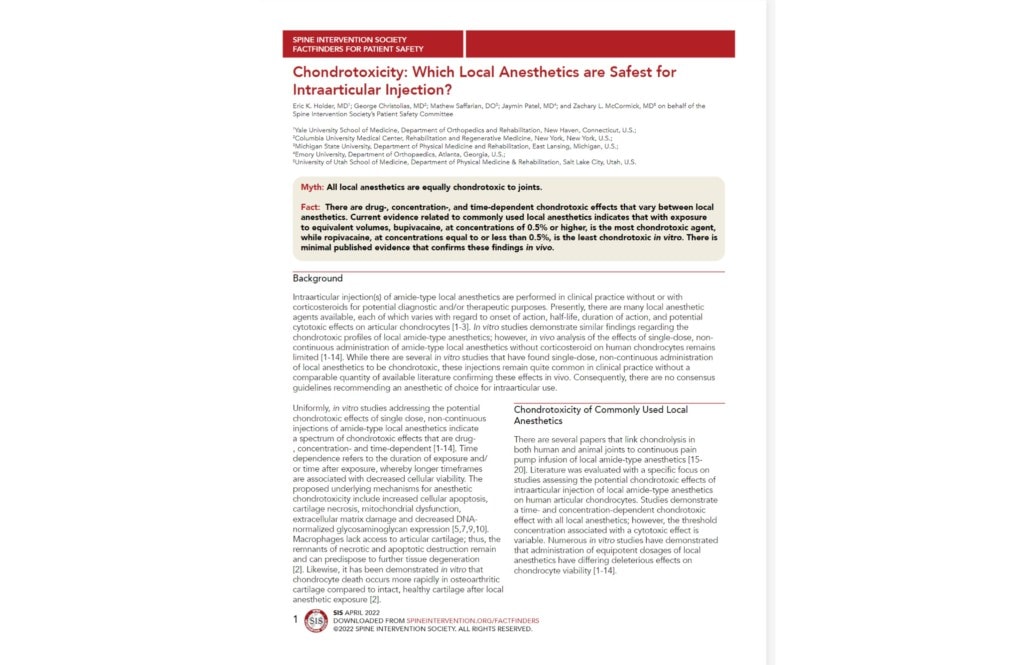Interventional Spine Physicians Finally Get the Memo on Bupivacaine

Credit: Shutterstock
It would be hard for most people to believe that we’ve known for more than a decade that a long-acting anesthetic called Bupivacaine is toxic to cartilage and yet in interventional pain management, it’s still the most widely injected anesthetic into joints. Why that disconnect exists says much about the problems in modern medicine, but thankfully now it’s finally being rectified by a guidance document put out by the Spinal Intervention Society (SIS). Let’s dig in.
Local Anesthetics in Injection Care
Local anesthetics are a mainstay of spinal and peripheral joint injections. They can be injected to help with pain control during procedures as well as be used for diagnostic blocks. That means that the doctor can inject a local anesthetic into a part of the spine believed to be painful. If the pain goes away, the doctor has identified the right structure to treat.
These local anesthetics come in many flavors. One of the main differences is how long they work. Since a longer-acting anesthetic can give more working time in an area or a diagnostic block that lasts longer, anesthetics like bupivacaine (Marcaine), which lasts for 3-12 hours, have long been physician favorites. The problem is that through the years, all sorts of data has been published on the toxicity of bupivacaine.
A Canary in the Coal Mine
Around 2005, some physicians began using pain pumps loaded with bupivacaine in shoulder surgery. The idea was that this would allow for less narcotic use as the joint that was operated on could be made numb for days. However, young patients began turning up with shoulders completely devoid of all cartilage. Basically a 75-year-old shoulder joint in a 25-year-old. Research around that time showed that the bupivacaine was likely to blame (1). This was a major scandal that launched many class-action lawsuits and it didn’t take a rocket scientist to wonder what would happen to cartilage if you just injected bupivacaine into the joint a single time.
Our Research On Bupivacaine
Shortly after the bupivacaine pain pump disaster went down, I started asking, is this stuff hurting our stem cells? We did a simple in-house lab study in 2007 when we added tiny amounts of bupivacaine to human bone marrow mesenchymal stem cells growing in culture. That totally wiped out our cells. Hence, we threw away all vials of the stuff in our clinic and never ordered another one.
The Research on Bupivacaine Chondrotoxicity
Later on, we published a lab study on several local anesthetics trying to find which was best (2). Originally we hadn’t decided to turn our in-house study into a formal published one, but another author published a study claiming that Marcaine was fine, which made no sense given our experience. We reviewed that study and found that the authors only relied on the binary concept of cells being alive or dead and not in between. Obviously, we all know from a hospital that there are patients who are alive and healthy, alive and dying (in the ICU), and dead. Hence any bupivacaine study would need to include all three categories, which didn’t happen in the new study. Hence, we did a new and more sophisticated study and published that paper. It showed what we had seen before, bupivacaine is a nasty drug when it comes to stem cells. Others then published studies showing that bupivacaine was toxic to knee cartilage. Finally, in 2018, a larger study reviewed many published papers and also concluded that bupivacaine was toxic to joint cartilage (3).
Societies and Bupivacaine
In 2012, the American Academy of Orthopedic Surgeons (AAOS) issued a warning about bupivacaine toxicity in joints. That made sense based on the evolving evidence. However, we still continued to see patients come in from interventional pain practices where diagnostic joint blocks were still performed with bupivacaine. This clearly wasn’t consistent with what had been published about this nasty drug.
The New SIS Position Paper on Local Anesthetics
The Spine Intervention Society (SIS) is a major player in educating physicians about how to safely perform x-ray-guided spine injections. So if they put something out, that may impact the behavior of doctors performing these procedures. In April, they put out a position paper/review showing, you guessed it, that bupivacaine is a bad anesthetic that kills cartilage. Who would have guessed? While they are late to the party, at least this document could help reduce the cartilage damage caused by injections.
What Can You Do as a Patient?
if you’re getting any spine or joint injections, ask if the doctor is planning to use Marcaine or bupivacaine and if the answer is “Yes”, ask them to substitute Ropivacaine, an anesthetic that is cartilage friendly. If you get a blank stare, then find another doctor, as this evidence is clear enough that nobody in 2022 should be using bupivacaine in spinal or peripheral joint injections.
The upshot? We have known for a very long time that the local anesthetic bupivacaine is a major problem. If you’re a doctor, hopefully, you’ve already gotten the memo. If you’re a patient, then please ask whether your doctor is planning on using this stuff!
____________________________________________________
References:
(1) Gomoll AH, Kang RW, Williams JM, Bach BR, Cole BJ. Chondrolysis after continuous intra-articular bupivacaine infusion: an experimental model investigating chondrotoxicity in the rabbit shoulder. Arthroscopy. 2006 Aug;22(8):813-9. doi: 10.1016/j.arthro.2006.06.006. PMID: 16904576.
(2) Dregalla RC, Lyons NF, Reischling PD, Centeno CJ. Amide-type local anesthetics and human mesenchymal stem cells: clinical implications for stem cell therapy. Stem Cells Transl Med. 2014 Mar;3(3):365-74. doi: 10.5966/sctm.2013-0058. Epub 2014 Jan 16. PMID: 24436443; PMCID: PMC3952925.
(3) Kreuz PC, Steinwachs M, Angele P. Single-dose local anesthetics exhibit a type-, dose-, and time-dependent chondrotoxic effect on chondrocytes and cartilage: a systematic review of the current literature. Knee Surg Sports Traumatol Arthrosc. 2018 Mar;26(3):819-830. doi: 10.1007/s00167-017-4470-5. Epub 2017 Mar 13. PMID: 28289821.

NOTE: This blog post provides general information to help the reader better understand regenerative medicine, musculoskeletal health, and related subjects. All content provided in this blog, website, or any linked materials, including text, graphics, images, patient profiles, outcomes, and information, are not intended and should not be considered or used as a substitute for medical advice, diagnosis, or treatment. Please always consult with a professional and certified healthcare provider to discuss if a treatment is right for you.

